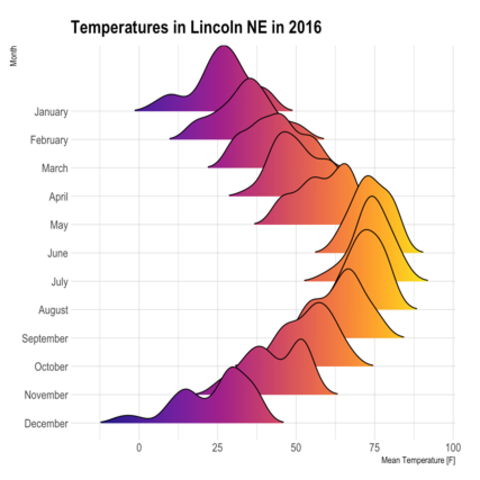Replies: 7 comments 21 replies
-
|
Hey @fkiraly happy to see you here! Give me some time to take a look at this one as I'm not super familiar with that class of forecasters from sktime.
If I understood correctly, this is completely fine when it comes to interacting with ridgeplot, since we also accept x-y traces as input -- bypassing the KDE step altogether |
Beta Was this translation helpful? Give feedback.
-
Most popular forecasters have a probabilistic prediction mode, and they can be filtered by the tag Check it out in the forecasting tutorial, the main tutorial of
Yes - in the conceptual space of |
Beta Was this translation helpful? Give feedback.
-
|
@fkiraly Just trying to get some early feedback from you. I just tried to map this output from sktime's 
into a ridgeline plot of PDFs (for the same forecast horizon): 
👆 this is what I was able to hack together while trying to figure out how the Let me know if this is anything like what you had envisioned, otherwise, could you share a more concrete example I can play around with. A sketch would help. |
Beta Was this translation helpful? Give feedback.
-
A few examples and references that use this method to visualise probabilistic forecastsThis includes both univariable and panel series examples. Granted that this is not a very significant sample but just for reference:

👉 https://seita.nl/2019/10/22/how-to-plot-probabilistic-forecasts/ 
👉 https://link.springer.com/article/10.1007/s11222-023-10212-8 
People seemed to have liked this way of visualising probabilistic forecasts. Here the non-OP top comment: 

👉 https://wilkelab.org/ggridges/articles/introduction.html#varying-fill-colors-along-the-x-axis |
Beta Was this translation helpful? Give feedback.
-
|
Some design questions:
|
Beta Was this translation helpful? Give feedback.
-
|
@tpvasconcelos, here's a PR with a plotting interface, for probabiliy distributions in I was thinking about - and have designed it in that way - to allow different backends for plotting. So, if used in a time series context, the distributions could automatically be switched to temporal plotting mode, why the panel mode makes more sense for tabular datasets where distributions are in no particular order. |
Beta Was this translation helpful? Give feedback.
-
|
@fkiraly sorry for the radio silence. I lost the code I wrote to produce this initial draft which took me some time to get working. I will try to take a look at this again. I think that now that we have the gradient fill that you liked, the plots could look much nicer too :) |
Beta Was this translation helpful? Give feedback.


-
For a while I have now been thinking about what a good plotting modality would be for fully distributional predictions, i.e., the output of
predict_probainsktimeorskpro.The challnge is that you have a (marginal) distribution for each entry in a
pandas-like table, which seems hard to visualize. I've experimented with panels (matplotlib.subplots) but I wasn't quit happy with the result.Now, by accident (just curious clicking), I've discovered
ridgeplot.What would you think of using the look & feel of
ridgeplotas a plotting function inBaseDistribution? Where rows are the rows of the data-frame like stucture, and mayb there are also columns (but I am happy with the single-variable case too)The main difference is that the distribution does not need to be estimated via KDE, you already have it in a form where you can access
pdf,cdf, etc, completely, and you have the quantile function too which helps with selecting x-axis range.Plotting
cdfand other distribution defining functions would also be neat, of coursepdf(if exists), orcdf(for survival) are already great.Imagined usage, sth like
Dependencies-wise, one could imagine
ridgeplotas a plotting softdep likematplotliborseaborn, ofskproand therefore indirectly ofsktime.What do you think?
Beta Was this translation helpful? Give feedback.
All reactions